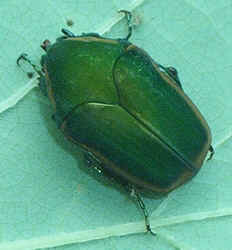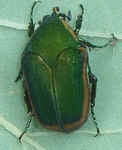 |
 |
Green June Beetle
Scientific Name: Cotinis nitida
Family Name: Scarabaeidae
Serendipity Ranch
Columbus, North Carolina
 |
 |
Scarab Beetles, Antennae distinctive -- each one ends in a lamellate club of 3-4 (rarely up to 7) segments; segments expanded laterally into oval or elongate lobes that can be closed tightly; each antenna has 8-11 segments. Body form variable -- usually stout and heavy-bodied, oval to elongate. Tarsi 5-5-5. 2-62 mm (most 2-20 mm). Many are found on flowers, where they feed on pollen; some live under bark or in rotting wood; a few live in ant nests. Tarsal claws are simple and equal in size; front coxae are conical; body is more or less flattened above. None of these beetles has horns. Larvae feed on roots, organic material in soil, or decaying trees. The Green June Beetle is 20-23 mm long (southern U.S.). Larvae feed on hummus and roots in lawns and gardens; they have the habit of crawling on their backs. Adults eat foliage, flowers, and sometimes fruit and are active in daytime. [White, Richard E., Peterson Field Guide Series: A Field Guide to the Beetles of North America, Houghton Mifflin Company, Boston, 1983]
Flower Beetles and Others. These have tarsal claws simple and equal in size, front coxae conical, and the body flattened dorsally; the lateral margins of the elytra (forewings) are often narrowed behind the front corners, and there are no horns. Our species are small to moderate-sized, but some African species (Goliath beetles) reach a length of 4 of 5 inches. Adults of most species are pollen feeders, found on flowers; some feed on the juices of decaying wood and re found underbark. Larvae occur in the soil and often damage roots. Adults of the Green June Beetle, a dark green beetle about 1 inch, feed on grapes, ripening fruit, foliage, and young corn; larvae, which have the habit of crawling on their back, feed in the soil on plant roots. This beetle is common in the southeastern states. [Borror, Donald J. and White, Richard E., Peterson Field Guide Series: A Field Guide to the Insects of America North of Mexico, Houghton Mifflin Company, Boston, 1970]
3/4-7/8". Robust, elongate, somewhat flattened. head dark, with a horn. Pronotum and elytra are metallic green, with brownish yellow on the sides; the underside is glittery green and brownish yellow. Tibiae green; femora are brownish yellow. Larva, to 2", is yellowish white with brown head. Habitat: Gardens, orchards, open woods, and crop fields, particularly above sandy soil. Range: New York to Florida and Gulf states, north to Missouri. Food: Adult drinks pollen from open flowers, such as hollyhock, and devours ripening fruits, especially peaches, and the foliage and fruits of many trees and shrubs. Larva eats roots of grasses, alfalfa, vegetables, tobacco, ornamental plants, and many other plants. Life Cycle: Grayish, spherical eggs are laid in oil with high organic content. Larvae often emerge after a prolonged rain, crawl on their backs over soil or through sod, and overwinter deep in soil. Larvae develop in earthen cells near soil surface and pupate in the late spring of the 2nd year after hatching. Adults emerge June-July. 1 generation a year. Adults fly noisily at night in search of food. This beetle is often an agricultural pest because its larvae destroy the roots of valuable plants, especially tobacco. [Milne, Lorus and Margery, National Audubon Society Field Guide to North American Insects and Spiders, Alfred A. Knopf, New York, 1980]